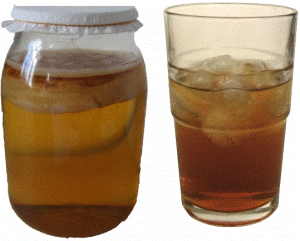Kombucha is very popular and easy to make. By making your own kombucha, you will always have a starter, the ‘mother,’ which you can use for future batches or give a mother to a friend for them to make their own kombucha.
Serves: 16
Timeframe: About 7 days
4 quarts
1 cup sugar * note on sugar, below
4 tablespoons or 4 teabags
1 cup mature acidic kombucha
kombucha mother
INSTRUCTIONS
Mix water and sugar and bring to a boil in a small pot. Turn off the heat; add tea, cover and steep about 15 minutesStrain the tea into a glass container. It’s best to use something wide; kombucha needs adequate surface area and works best if the diameter of the container is greater than the depth of the liquid. Allow the tea to cool to body temperature. Add the mature acidic kombucha. When you obtain a culture, it will be stored in this liquid. Save a portion of subsequent batches for this purpose. Place the kombucha mother in the liquid, with the firm, opaque side up. Cover with a clean cloth and store in a warm spot, ideally 70 to 85 degrees. After a few days to 1 week, depending on temperature, you will notice a skin forming on the surface of the kombucha. Taste the liquid. It will probably still be sweet. The longer it sits, the more acidic it will become. Once it reaches the acidity that you like, start a new batch and store your mature kombucha in the fridge. You now have 2 mothers, the original one you started with, and a new one, the skin that formed on your first batch. Use either the new or the old mother in your new batch, and pass the other one on to a friend. Each generation will give birth to a new mother and the old mother will thicken.
Sugar:
Plain White Cane Sugar. Plain white sugar (the type you find at every conventional grocery store) is the easiest variety for the scoby to digest during the fermentation process, thereby creating a brew with the most consistent pH level. Unfortunately plain white sugar is not generally organic and may contain pesticides or be produced from genetically modified crops, which may be detrimental to the health of the scoby.
Organic Evaporated Cane Crystals. The organic equivalent of plain white sugar, OECC is a bit less processed and therefore not quite as digestible for the scoby, but still creates a brew with a consistent pH level. While not perfect, since it does not contain pesticides, GMOs, etc., it is very popular among kombucha brewers and is the sugar of choice here at Cultures for Health both for production of the kombucha scobys available on our website as well as for our own personal brewing projects.
Brown Sugar, Rapadura, Sucanat, Turbinado, Raw Sugar, Molasses. Sugars containing molasses (unrefined sugars) can be used to brew kombucha but are much more difficult for the scoby to digest and therefore may result in a less consistent fermentation process and resulting level of acidity. A poorly formed new scoby and excessive yeast sediment are common side effects. Please note: sugars containing molasses also yield a much less pleasant-tasting kombucha. We do not recommend using sugars containing molasses when brewing kombucha, but if you choose to use them, try boiling the sugared tea for 10 minutes prior to allowing the mixture to cool completely and using it to make kombucha. The boiling process is purported to break down the sugar, which allows the scoby to better utilize the sugar for fermentation. While not ideal, it may help a bit. If using one of these sugar types, we recommend obtaining and using a reliable pH meter or pH testing strips to ensure the pH level of your kombucha is between 2.6 and 4.0 prior to consumption.
Honey. Pasteurized honey may be used. Raw honey may successfully be used to brew kombucha, but we do not recommend it for a number of reasons. Raw honey has its own bacterial profile and may disrupt the balance of yeast and bacteria in the scoby. Additionally, raw honey may include organic material that might disturb the scoby or attract mold. Keep in mind that such disruption isn’t always obvious and may result in an unsafe batch the first time or several batches later.
Agave. Agave can be used but it yields a sour-tasting kombucha and is problematic for the long term health of the scoby. We do not recommend using agave.
Maple Syrup, Coconut Sugars, Rice Syrup, etc. While it may be possible to use these sugars when making kombucha, we recommend exercising extreme caution as good data does not currently exist as to their safety for the scoby either in the short or long term. If you decide to experiment using one of these alternative sugars, we urge you watch your batch carefully for any signs of mold or breakdown of the scoby. You should also obtain and use a reliable pH meter or pH testing strips to ensure the pH level of your kombucha is between 2.6 and 4.0 prior to consumption.
DO NOT USE: Corn syrup (or high fructose corn syrup), lactose, Sucralose, aspartame, acesulfame potassium, saccharin, Neotame, xylitol, or stevia. None of these sweeteners can be utilized as food by the scoby and will be detrimental to the batch and harmful to the scoby, and will produce a beverage that is unsafe to consume.

